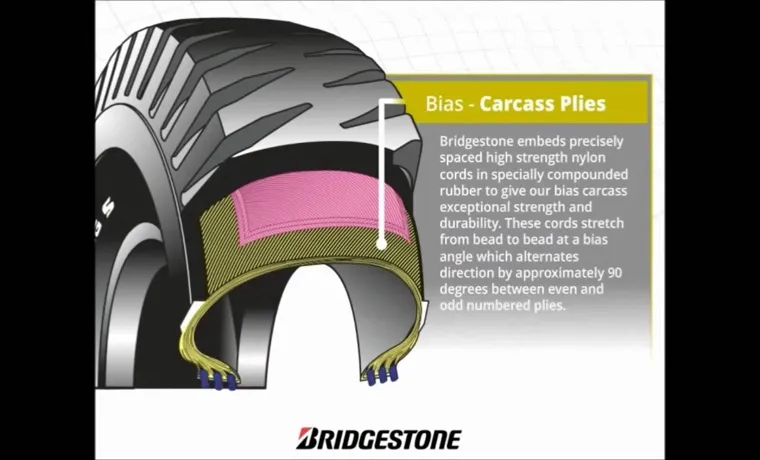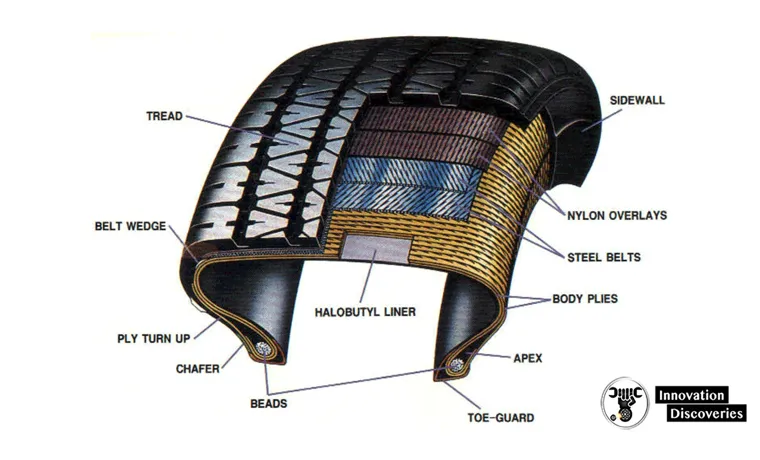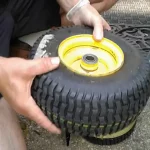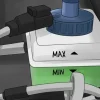Have you ever wondered about the different components that make up your car tires? One of the key elements that often goes unnoticed is the carcass plies. These plies play a crucial role in ensuring the tire’s strength and durability, which directly impacts the safety and performance of your vehicle. In this blog post, we’ll take a closer look at the purpose of carcass plies in a tire and how they contribute to optimal driving experiences.
So, let’s dive in and explore this essential tire component!
Table of Contents
What are Carcass Plies?
Carcass plies are an important component of tires that provide strength and stability to the structure. They are located between the rubber tread and the inner liner of the tire and are made up of layers of cords, usually made of polyester or nylon. The purpose of carcass plies is to hold the tire’s shape and resist the pressure of the air inside.
In addition, they help to distribute the vehicle’s weight evenly across the tire, allowing for better traction and handling. The number of carcass plies in a tire can vary depending on the manufacturer’s specifications, with some tires having more plies for increased durability and strength. Overall, carcass plies play a vital role in ensuring the reliability and safety of tires, making them an essential component to consider when choosing an appropriate tire for your vehicle.
Definition and Composition
Carcass plies are one of the vital components of a tire, responsible for providing strength and stability. These plies are essentially layers of fabric that make up the tire’s internal structure. Generally, carcass plies are made from polyester, rayon, or nylon.
These materials are known for their strength and durability, making them ideal to withstand the pressures and forces exerted on the tire during operation. The number of carcass plies used in a tire may vary depending on the size, load capacity, and intended use of the tire. The thickness and angle of the plies also have a crucial role in determining the tire’s handling and performance.
Overall, carcass plies play a crucial role in ensuring the safety and reliability of the tire, making it vital to choose the right tire with the right number and type of carcass plies for your vehicle.

Number of Carcass Plies
Carcass plies are layers of fabric that reinforce a tire’s structure and provide stability. They are located between the inner liner and the tread of the tire and are made of various materials, such as nylon, rayon, or polyester. The number of carcass plies a tire has is an essential factor that determines its strength and durability.
Each ply adds strength to the tire, and the more plies a tire has, the stronger it will be. Additionally, having more plies can help increase the tire’s load capacity, making it able to carry heavier loads. Carcass plies also play a key role in preventing punctures and blowouts, providing extra support to the tire against rough roads.
Overall, more carcass plies equal more strength and durability, making them a crucial consideration when selecting the right tire for your vehicle. So, it’s always better to choose a tire with the appropriate number of carcass plies for your needs.
The Role of Carcass Plies in Tire Construction
If you’re wondering what the purpose of carcass plies is in a tire, you’re not alone. These plies are layers of fabric situated between the tire’s inner liner and the beads that hold it in place. Their primary function is to provide the tire with strength and stability, working in tandem with the belts to keep the tire from expanding under the force of centrifugal force.
Basically, they act as the tire’s backbone, allowing it to bear the weight of the vehicle and its occupants. Without carcass plies, a tire would have a hard time holding its shape and keeping its tread firmly on the road, leading to unsafe driving conditions and uneven wear patterns. In summary, carcass plies are essential to a tire’s integrity, making it possible for it to perform reliably and safely on the road.
Strength and Durability
Carcass plies play a crucial role in a tire’s strength and durability. These plies are made of multiple layers of rubber-coated fabric that are tightly woven together to form a strong foundation for the tire. The number and thickness of these plies vary depending on the intended use of the tire, with more plies used for heavy-duty applications.
Carcass plies provide strength and support to the tire, ensuring it can hold the weight of the vehicle and withstand various road conditions. They also help prevent punctures and tears, ensuring the tire stays intact for longer. Overall, the quality and design of the carcass plies are important factors to consider when selecting a tire that will provide reliable performance and longevity.
Resistance to Deformation
Resistance to deformation is a crucial factor to consider when building a tire. Carcass plies play a vital role in helping tires withstand the pressure and weight of a vehicle while on the road. The carcass is essentially the framework of the tire, made up of layers of fabric cords or steel belts coated in rubber.
These plies give the tire strength and rigidity, helping it maintain its shape and resist deformation. The thickness and number of plies used vary depending on the size and type of tire, with larger and heavier tires requiring more plies for added durability and resistance to deformation. Additionally, the quality of the carcass material used can greatly impact the tire’s overall performance and lifespan.
By using high-quality carcass plies, tire manufacturers can produce more reliable and long-lasting tires that can withstand the toughest driving conditions.
Ability to Handle Load
The ability to handle load in a tire is an essential characteristic that determines its performance and safety. Carcass plies play a crucial role in the construction of a tire to ensure its ability to handle load. These plies are layers made of high-strength textile materials that are placed between the tire’s inner liner and tread.
They provide structural integrity to the tire’s casing, allowing it to withstand the stresses caused by the vehicle’s weight and motion. The number, orientation, and quality of the carcass plies influence a tire’s load-carrying capacity, cornering stability, and overall durability. A tire with more carcass plies is typically stronger and more resistant to punctures, while a tire with fewer plies is more flexible and provides a smoother ride.
The right balance between strength and flexibility is critical in determining a tire’s load handling ability and overall performance. So, if you want a safe and durable tire that can handle heavy loads, make sure to choose one with high-quality carcass plies.
Benefits of Carcass Plies in Tires
When it comes to the anatomy of a tire, the carcass plies play a vital role in providing the necessary strength and support. Essentially, the carcass plies are layers of fabric that are located between the tire tread and the inner liner. Their purpose is to provide stability and structure to the tire by helping it maintain its shape and resist deformation under pressure.
Additionally, the carcass plies help to absorb shock and impact forces, which can improve the overall ride comfort and handling of the vehicle. By incorporating multiple layers of carcass plies, tire manufacturers can create tires that are capable of handling higher loads and speeds, which is why they are often used in commercial and performance applications. All in all, the carcass plies serve as a critical component in ensuring the safety and performance of your vehicle’s tires.
Improved Handling and Stability
Carcass plies are one of the essential components of a tire that plays a crucial role in improving its handling and stability on the road. These plies are made of fabrics like polyester, nylon, or steel cords that are laid in a criss-cross manner and bound together with rubber. The number of plies used in a tire depends on its size, load capacity, and speed rating.
The more plies a tire has, the sturdier it is, and the better it can resist punctures and damage from road debris. But what makes carcass plies so important for a tire’s performance? Well, they provide the structural integrity and strength needed to support the weight of the vehicle and its occupants. They also help distribute the tire’s load evenly across the contact patch, which increases the tire’s grip on the road.
This translates into improved handling and steering response, especially during sudden maneuvers or emergency braking. Additionally, the carcass plies act as a shock absorber that dampens the vibrations and impacts caused by the irregularities on the road surface. This means a smoother and more comfortable ride for the driver and passengers.
Furthermore, the plies can help prevent the tire from overheating by dissipating the heat generated during high-speed driving. In conclusion, the use of carcass plies in tires has significant benefits that improve the overall driving experience and safety. These plies offer added strength, stability, and shock absorption that are critical for a tire’s performance.
If you’re looking for a tire that provides exceptional handling and stability, make sure to check the number and quality of carcass plies it has, as they can make a significant difference in your driving experience.
Reduced Risk of Damage or Blowouts
When it comes to the safety of your vehicle, you want to ensure that your tires are in good condition and performing at their best. One important aspect of tire design that can help reduce the risk of damage or blowouts is the use of carcass plies. Carcass plies are layers of fabric that are embedded in the rubber of the tire, running from bead to bead.
These plies provide strength and stability to the tire, helping it to withstand the stresses of driving over rough or uneven terrain. By incorporating carcass plies into their tires, manufacturers are able to offer drivers increased durability and resistance to punctures or other types of damage. This means that drivers can enjoy a safer, more reliable driving experience, with less risk of a blowout or other type of tire failure.
So if you’re looking for a tire that can help keep you safe on the road, look for one that features carcass plies – it could make all the difference!
Conclusion
So, after pondering the purpose of carcass plies in a tire, we can conclude that they are the unsung heroes of the tire world – providing structural support and stability to make our journeys safer and smoother. Without these plies, our tires would be lost, like a ship without a mast or a bird without wings. So, let us give a round of applause to these humble plies and their tireless work to keep us rolling!”
FAQs
What are carcass plies in a tire?
Carcass plies are layers of textile cords that make up the basic structure of a tire and provide strength and stability to the tire.
How many carcass plies are there in a tire?
This can vary depending on the type and size of the tire, but most passenger car tires have two or three carcass plies.
What is the purpose of carcass plies in a tire?
The purpose of carcass plies in a tire is to provide the required strength and rigidity needed to support the weight of the vehicle, absorb shocks and vibrations, and maintain the shape and stability of the tire.
How are carcass plies made?
Carcass plies are typically made from high-strength textile cords such as polyester, nylon, or rayon that are coated in rubber for added durability and adhesion to the other tire components.
Can the number of carcass plies affect the performance of a tire?
Yes, the number and quality of carcass plies can affect the performance of a tire, as they impact the tire’s load capacity, handling, and durability.
How are carcass plies different from other tire components like tread and sidewalls?
Carcass plies are the foundational layer of a tire and provide the necessary structure and support, while the tread and sidewalls provide traction, grip, and protection from external damage.
Are there any safety concerns related to carcass plies in tires?
Any issues with carcass plies can cause serious safety concerns, such as blowouts or tire failure while driving, highlighting the importance of regularly inspecting and maintaining your tires.



